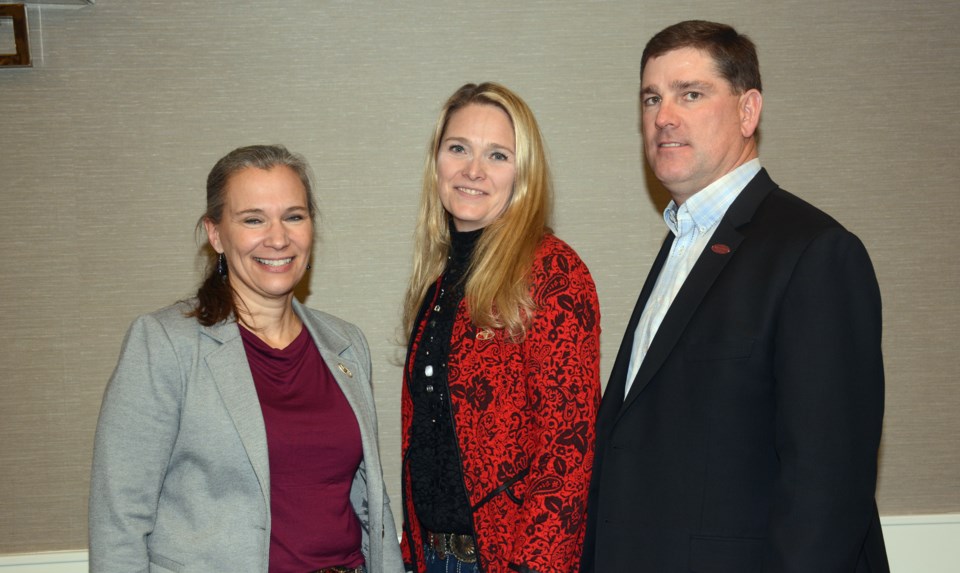WESTLOCK - Alberta Beef Producers celebrated its 50th year as an organization earlier this fall and at the association’s AGM held in Calgary this past week, Dec. 2-4, they began the second half century with a new direction and some firsts.
Kelly Smith-Fraser of Pine Lake in Red Deer County (Zone 5), last year’s vice-chair, was elected as the new chair for the organization — the first woman to hold the position.
Melanie Wowk of Beauvallon (Zone 8) was elected vice-chair, and Brad Osadczuk of Jenner (Zone 1) was elected as the new finance chair. Thirteen more individuals from across the nine ABP zones form the board of directors for the coming year. Charlie Christie, last year’s chair remains on as past chair in an advisory capacity.
Smith-Fraser and the new board have a very busy and challenging year ahead of them. At this year’s AGM, resolutions were passed to streamline the operation.
The number of zones will be reduced from the current nine to five and instead of being numbered they will become Southeast, Southwest, Central, Northeast and Northwest. The number of delegates will also be reduced from the current 54 to 35, with the board also reduced from 16 to 12. It is hoped the process to make the changes will be completed hopefully by June, 2020 in time for the semi-annual AGM, and the transition to the new structure in place for the 2020 AGM next December in Calgary.
Along with the changes to the structure comes the extra challenge to the board of finding a new executive director as Rich Smith, the current executive director, will be retiring this summer.
Smith-Fraser is basically hitting the ground running and said Dec. 5 she knows she has a busy and challenging year ahead. Friday, along with others, she said she would be meeting with Alberta Agriculture and Forestry Minister Devin Dreeshen, who ironically is a neighbour.
“We’ll begin the transition work (nine zones to five) right away. We’ll still have to hold a semi-AGM in the spring. There, the delegate body will have to vote on the items that require a by-law change, like the number of delegates and the number of zones.”
The second big challenge is to find a new executive director.
“It’s a daunting task,” she said. “Rich (Smith) has been in that position for so long, and he understands the industry. He knows the people; he knows the numbers. It’s amazing his memory recall on decisions and things. It’s going to be next to impossible to find the right person.
“We will definitely miss him immensely.”
As for herself as the new board chair she said, “I’ll be perfectly honest. It’s a daunting task. I grew up with a dad that was involved in the Alberta Cattle Commission (the original name of ABP). He wasn’t a chair, but he stayed very involved all throughout his time, and chaired a committee.”
In many ways, she sees her late father, Gary Smith, as the mentor that set the groundwork for her new role as ABP chair today.
“He was like a machine. My dad wasn’t involved in any of the organizations then, but he was on the phone constantly with CFIA and CCA and trying to figure out what markets could get open. We exported live cattle and genetics. I saw how the machine works, and how producers can make a change in it. As a kid growing up and somebody watching how it can change somebody’s business; I find it an incredibly daunting task, because I know how important our organizations are.
“I always saw what a deep respect my dad had for the people that did become the ABP chairs, and to me, it’s really daunting to look at it and say, that’s me now.”
On the personal side, she runs a purebred Maine-Anjou operation a few miles west of Pine Lake. Her grandfather was one of the first to import the breed into Canada, back about 1967. Her father and his two brothers originally were at Winborne.
“One us kids all got coming home from college and university and we had to do something. We had to expand and get bigger. We felt that separating would probably be better for the families. We sold what we had at Winborne. We had some pasture land at Pine Lake, so we (she and her brother and parents) moved here.”
Today, she raises show calves for 4-H kids and the prospect shows, and has been running the ranch for about 16 years, selling purebreds locally.
“We had a long history of exporting cattle, embryos and semen,” she said, but after her dad passed away four years ago they folded that. The herd was downsized just before her dad passed away from about 300 cows.
“Today, we’re sitting at about 140 mama cows now. We’ll raise some commercial calves, but my goal is to raise purebreds. I’ve got a pretty decent bull market (all domestic, and mostly to commercial breeders, typically in the central Alberta area, she said). I’ll sell some heifer calves, but I try to retain most of the top end within my own herd.”
She’s the one who looks after the ranch for the most part. Her brother, who lives in Oklahoma, helps her with the breeding decisions, and has the pedigree knowledge.
Her role as ABP Chair role will keep her very busy, but she has neighbours who will help her when she needs it. “I’m pretty lucky, I’ve got some really good neighbours, and my husband usually doesn’t complain too much if we spend the weekend doing cow stuff. I’ve got a little girl; she’s eight, and somehow she’s already a big help. I guess she just learned it by osmosis.”



